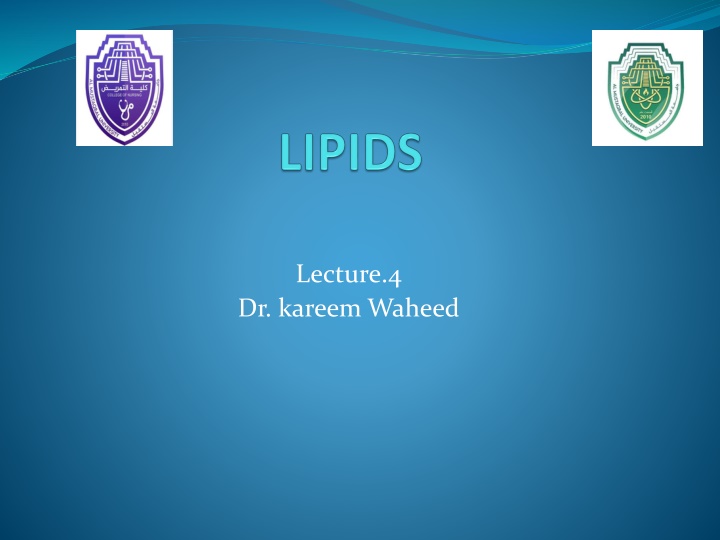
Lipids: Functions, Classification, and Fatty Acids
Explore the world of lipids with a focus on their functions, classification into simple, compound, and derived lipids, and the traits of saturated and unsaturated fatty acids. Learn about essential and non-essential fatty acids, and discover the importance of lipids in providing energy, supporting cell membranes, and more.
Download Presentation

Please find below an Image/Link to download the presentation.
The content on the website is provided AS IS for your information and personal use only. It may not be sold, licensed, or shared on other websites without obtaining consent from the author. If you encounter any issues during the download, it is possible that the publisher has removed the file from their server.
You are allowed to download the files provided on this website for personal or commercial use, subject to the condition that they are used lawfully. All files are the property of their respective owners.
The content on the website is provided AS IS for your information and personal use only. It may not be sold, licensed, or shared on other websites without obtaining consent from the author.
E N D
Presentation Transcript
Lecture.4 Dr. kareem Waheed
Lipids: are organic substances insoluble in water and soluble in organic solvents such as ether, alcohol, acetone, etc.
Functions of Lipids 1. Providing energy, each gram of fat give 9 kcal, fats are essential for the functioning and structure of body tissues. 2. Fats are a necessary part of cell membranes (cell walls). 3. They contain essential fatty acids and act as carriers for fat- soluble vitamins A, D, E, and K. 4. The fat stored in body tissues. 5. Adipose (fatty) tissue protects organs and bones from injury. 6. Fats provide a feeling of satiety (satisfaction) after meals.
Classification of lipids Simple lipids 1. Compound lipids. 2. Derived lipids. 3. .
1- Simple lipids: Esters of fatty acids (FA) with alcohol. Simple lipids are further classified into: a. Fats: Esters of fatty acids with glycerol. These are solid at room temperature. b. Oils: Fats, liquids at room temperature. c. Waxes: Have long chain fatty acids and an alcohol (cholesterol).
FattyAcids These are the simplest forms of lipids. Classification of fatty acid: Essential fatty acid: Cannot be synthesized in the body a. (obtained through diet)(omega-3 and omega-6). Non-essential fatty acid: Can be synthesized in the body. b.
Fatty acids can be: 1- Saturated F.A: without double bond are typically solid at room temperature. Examples include meat, poultry, egg yolks, whole milk, whole milk cheeses, cream, ice cream, and butter. C-C-C-C-COOH
\ 2. Unsaturated F.A: An unsaturated fat is a fat or fatty acid in which there is one or more double bond in the fatty acid chain. Plant foods generally contain more polyunsaturated fatty acids than saturated fatty acids. C-C-C=C-C=C-COOH
*Unsaturated F.Adivided to: 1- Monounsaturated Fats: Found in olive oil, peanut oil, canola oil, and avocados. The monounsaturated fats lower the amount of low-density lipoprotein (LDL) ( bad cholesterol ) in the blood. They have no effect on high-density lipoproteins (HDLs) ( good cholesterol ). It is recommended that one consume 15% of total daily calories as monounsaturated fats.
2- Polyunsaturated Fats: 1. Omega-3 fatty acids: help lower the risk of heart disease are found in fish oils. 2. Omega-6 : has a cholesterol lowering effect. Polyunsaturated fats should not exceed 8 % of total daily calories.
Deficiency of essential fatty acids: 1. Growth failure. 2. Dry skin (eczema). 3. Poor wound healing. 4. Increase serum cholesterol.
Cholesterol. Cholesterol is a sterol. It is exists in animal foods and body cells. It does not exist in plant foods. Sources of cholesterol: 1. Exogenous ( from foods) it is found so in egg yolk, fatty meats, butter, cream, cheese, whole milk, and organ meats ( liver, kidneys, brains ). 2. Endogenous (synthesis in liver).The body manufactures 800 to 1,000 mg of cholesterol a day in the liver.
Function of cholesterol: It is essential for the synthesis of bile acid, sex hormones, cortisone, and vitamin D and is needed by every cell in the body. Cholesterol is contributing factor in heart disease because high serum cholesterol. The blood cholesterol levels most not exceed 200 mg/dl (200 milligrams of cholesterol per 100 ml of blood).
To lower blood cholesterol level: 1. Reduction in the amount of diet contain total fat and cholesterol. 2. Increase in the amounts of monounsaturated fats, weight loss, and exercise. 3. Dietary fiber also helpful in lowering blood cholesterol.
2. Compound lipids: Esters of fatty acids with alcohol and in addition have other groups. a. Phospholipids: Contain phosphate groups, in addition to lipid part. b. Glycolipids: Contain carbohydrate groups along with lipid part. c. Lipoproteins: Complexes of lipids and proteins. Example: High Density Lipoproteins (HDL). d. Sulfolipids: Contain sulfated carbohydrates with lipid part. Example: Sulfatides.
Lipoproteins Low-density lipoprotein(LDL). Elevated blood levels greater than 130 mg/dl of LDL are thought to be contributing factors in atherosclerosis. Low-density lipoprotein called(bad cholesterol).
High-density lipoproteins (HDL): good cholesterol. High-density lipoproteins called The Exercising, maintaining weight, stop smoking are all ways to increase one s HDL.
Digestion andAbsorption The chemical digestion of fats occurs mainly in the small intestine. Metabolism and Elimination The liver controls fat metabolism
. Deficiency of fat causes:. 1. Deficiency occurs, eczema. 2. Growth retarded. 3. Weight loss. Excessive fat in the diet can lead to: Obesity or heart disease. 1. Cancers of the colon, breast, uterus, and prostate. 2.
3. Derived lipids: Derived from simple and compound lipids after hydrolysis.











